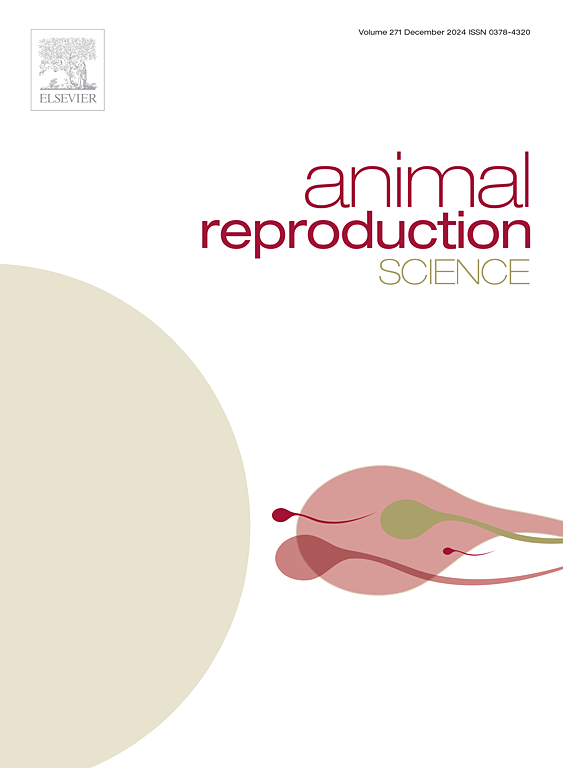长效重组猪卵泡刺激素对后备母猪和断奶母猪繁殖性能和生产效率的影响
IF 3.3
2区 农林科学
Q1 AGRICULTURE, DAIRY & ANIMAL SCIENCE
引用次数: 0
摘要
为了提高生产效率,马绒毛膜促性腺激素(eCG)在母猪繁殖管理中起着促进卵泡发育的重要作用;然而,eCG是一种从妊娠母马血清中提取的异源蛋白。在母猪繁殖管理中,开发和利用更具优势的替代产品是十分必要的。本研究首次应用一种新型长效重组猪卵泡刺激素(rpFSH-pFc)促进母猪同步发情。通过剂量筛选,我们发现40 μg rpFSH-pFc与200 IU hCG联合使用可有效促进后备母猪同步发情。此外,该组合可有效提高后备母猪雌二醇和孕酮的分泌。随后,将该组合应用于后备母猪和断奶母猪的同步发情。结果表明,联合激素处理组每窝活产仔猪数显著高于对照组(12.0 ± 1.9 vs. 10.6 ± 1.7,P <; 0.05)。虽然rpFSH-pFc和hCG联合治疗组的结果与eCG治疗组相似,但在相同的样本量下,与eCG治疗组相比,它导致仔猪总数(192头对176头)和断奶母猪总数(531头对481头)都更多。综上所述,rpFSH-pFc可能是促进母猪发情和排卵同步,提高畜牧生产繁殖效率的理想候选物质。本文章由计算机程序翻译,如有差异,请以英文原文为准。
Effects of long-acting recombinant porcine FSH on reproductive performance and production efficiency of gilts and weaned sows
To enhance production efficiency, equine chorionic gonadotropin (eCG) plays a crucial role in promoting follicular development in the reproductive management of sows; however, eCG is a heterologous protein derived from pregnant mare serum. It is essential to develop and utilize more advantageous alternative products in the reproductive management of sows. In this study, a novel long-acting recombinant porcine FSH (rpFSH-pFc) was used for the first time to promote synchronized estrus in sows. Through dose screening, we found that a combination of 40 μg of rpFSH-pFc and 200 IU of hCG effectively promoted synchronized estrus in gilts. Moreover, this combination could effectively enhance the secretion of estradiol and progesterone in gilts. Subsequently, this combination was applied to synchronize estrus in both gilts and weaned sows. Our results demonstrated that the combination hormone treatment group had a significantly higher number of piglets born alive per litter compared to the control group (12.0 ± 1.9 vs. 10.6 ± 1.7, P < 0.05). Although the treatment group receiving the combination of rpFSH-pFc and hCG exhibited outcomes similar to those of the eCG treatment group, it resulted in a greater total number of piglets in both gilts (192 vs. 176) and weaned sows (531 vs. 481), compared to the eCG treatment group, with equal sample sizes. Taken together, our results revealed that rpFSH-pFc might be an ideal candidate to promote the synchronization of estrus and ovulation in sows and improve the reproductive efficiency of livestock production.
求助全文
通过发布文献求助,成功后即可免费获取论文全文。
去求助
来源期刊

Animal Reproduction Science
农林科学-奶制品与动物科学
CiteScore
4.50
自引率
9.10%
发文量
136
审稿时长
54 days
期刊介绍:
Animal Reproduction Science publishes results from studies relating to reproduction and fertility in animals. This includes both fundamental research and applied studies, including management practices that increase our understanding of the biology and manipulation of reproduction. Manuscripts should go into depth in the mechanisms involved in the research reported, rather than a give a mere description of findings. The focus is on animals that are useful to humans including food- and fibre-producing; companion/recreational; captive; and endangered species including zoo animals, but excluding laboratory animals unless the results of the study provide new information that impacts the basic understanding of the biology or manipulation of reproduction.
The journal''s scope includes the study of reproductive physiology and endocrinology, reproductive cycles, natural and artificial control of reproduction, preservation and use of gametes and embryos, pregnancy and parturition, infertility and sterility, diagnostic and therapeutic techniques.
The Editorial Board of Animal Reproduction Science has decided not to publish papers in which there is an exclusive examination of the in vitro development of oocytes and embryos; however, there will be consideration of papers that include in vitro studies where the source of the oocytes and/or development of the embryos beyond the blastocyst stage is part of the experimental design.
 求助内容:
求助内容: 应助结果提醒方式:
应助结果提醒方式:


